
Do-it-yourself device, troubleshooting and repair of the VAZ 2101 cooling system
Content
- Engine cooling system VAZ 2101
- The device of the cooling system VAZ 2101
- Coolant
- Flushing the cooling system VAZ 2101
- The possibility of finalizing the cooling system VAZ 2101
The temperature in the chambers of an internal combustion engine can reach very high values. Therefore, any modern car has its own cooling system, the main purpose of which is to maintain the optimal thermal regime of the power unit. The VAZ 2101 is no exception. Any malfunction of the cooling system can lead to very unfortunate consequences for the car owner, associated with significant financial costs.
Engine cooling system VAZ 2101
The manufacturer installed two types of gasoline engines on VAZ 2101 cars - 2101 and 21011. Both units had a sealed liquid-type cooling system with forced refrigerant circulation.
Purpose of the cooling system
The engine cooling system (SOD) is designed not so much to reduce the temperature of the power unit during operation, but to maintain its normal thermal regime. The fact is that it is possible to achieve stable functionality and optimal power indicators from the motor only if it operates within certain temperature limits. In other words, the engine should be hot, but not overheated. For the VAZ 2101 power plant, the optimum temperature is 95–115оC. In addition, the cooling system is used to heat the car interior during the cold season and heat the carburetor throttle assembly.
Video: how the engine cooling system works
The main parameters of the cooling system VAZ 2101
Any engine cooling system has four main individual parameters, the deviation of which from the standard values can lead to system failure. These options are:
- optimal temperature of the coolant (coolant);
- engine warm-up time to operating temperature;
- optimal coolant pressure;
- coolant volume in the system.
Coolant temperature
The optimal temperature regime of the engine is determined by:
- type of fuel consumed;
- cylinder volume;
- calculated power.
For VAZ 2101, the engine temperature is considered to be from 95 to 115оC. The discrepancy between the actual indicators and the recommended values is a sign of a violation of the temperature regime. It is not recommended to continue driving in this case.
Engine warm-up time
The manufacturer's specified warm-up time for the VAZ 2101 engine to operating temperature is 4–7 minutes, depending on the time of year. During this time, the coolant should warm up to at least 95оC. Depending on the degree of wear of engine parts, the type and composition of the coolant and the characteristics of the thermostat, this parameter may slightly deviate (1–3 minutes) upwards.
Coolant working pressure
The coolant pressure value is the most important indicator of the efficiency of the SOD. It not only promotes forced circulation of the refrigerant, but also prevents it from boiling. From the course of physics it is known that the boiling point of liquids can be increased by increasing the pressure in a closed system. Under normal conditions, the coolant boils at 120оC. In a working VAZ 2101 cooling system, under a pressure of 1,3–1,5 atm, antifreeze will boil only at 140–145оC. Reducing the pressure of the coolant to atmospheric pressure can lead to a deterioration or cessation of the circulation of the liquid and its premature boiling. As a result, cooling system communications can fail and lead to engine overheating.
coolant volume
Not every owner of a "penny" knows how much refrigerant is placed in the engine of his car. When changing the fluid, as a rule, they buy a four- or five-liter coolant canister, and this is usually enough. In fact, the VAZ 2101 engine holds 9,85 liters of refrigerant, and when replaced, it does not drain completely. Therefore, when replacing the coolant, it is necessary to drain it not only from the main radiator, but also from the cylinder block, and you should immediately buy a ten-liter canister.
The device of the cooling system VAZ 2101
The VAZ 2101 cooling system includes the following elements:
- cooling jacket;
- liquid pump (pump);
- main radiator;
- cooling fan;
- heating module radiator with tap;
- thermostat;
- expansion tank (tank);
- temperature sensor with pointer;
- communication pipes and hoses.
Let us consider in detail the purpose, design and main malfunctions of each of the listed elements.


Cooling jacket
The cooling jacket is a set of specially provided holes and channels inside the cylinder head and the block itself. Through these channels, forced circulation of the coolant is carried out, as a result of which the heating elements are cooled. You can see the channels and holes if you remove the head from the cylinder block.
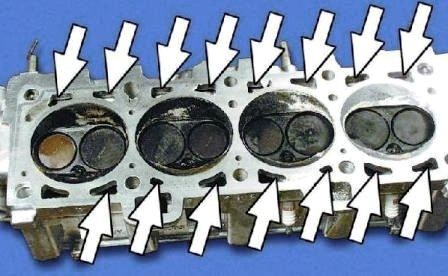

Cooling jacket malfunctions
A shirt can have only two faults:
- clogging of channels;
- surface damage due to corrosion.
In the first case, the throughput of the channels is reduced due to the ingress of debris, water, wear and oxidation products into the system. All this leads to a slowdown in the circulation of the coolant and possible overheating of the engine. Corrosion is a consequence of the use of low-quality coolant or water as a refrigerant, which gradually destroys and expands the walls of the channels. As a result, pressure drops in the system or its depressurization occurs.
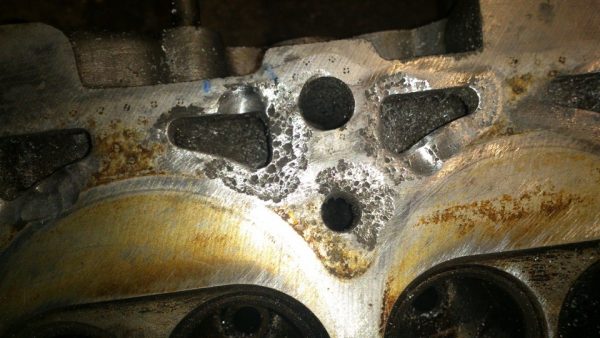

The use of antifreeze recommended by the manufacturer, its timely replacement and periodic flushing of the cooling system will help to avoid such problems. In the most advanced cases, only the replacement of the cylinder block or head will help.
Water pump (pump)
The air pump is considered to be the centerpiece of the cooling system. It is the pump that is responsible for circulating the refrigerant and maintaining the desired pressure in the system. The pump itself is mounted on the front wall of the engine block and is driven by a V-belt from the crankshaft pulley.
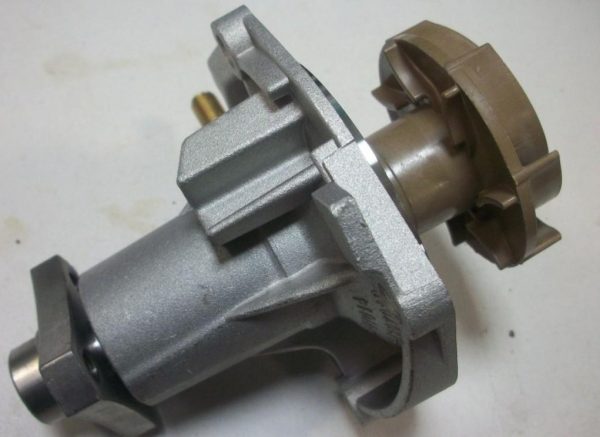

The device and principle of operation of the pump
The water pump consists of:
- housing;
- rotor with impeller, bearing and drive pulley;
- covers;
- stuffing box.
The principle of operation of the pump is similar to that of a conventional mechanically driven centrifugal pump. Rotating, the crankshaft drives the pump rotor, on which the impeller is located. The latter forces the refrigerant to move within the system in one direction. To reduce friction and ensure uniform rotation, a bearing is provided on the rotor, and an oil seal is installed at the location of the pump to prevent coolant from flowing out of the cylinder block.
Common pump malfunctions
The average operating life of a VAZ 2101 water pump is 50 thousand kilometers. It is usually changed along with the drive belt. But sometimes the pump fails much earlier. The reasons for this may be:
- manufacturing defects;
- incorrect drive belt tension;
- the use of low-quality coolant;
- the use of coolant, the properties of which do not meet the requirements of the manufacturer;
- the presence of water, dirt, corrosion products in the cooling system.
These factors can have both single and complex effects on the state of the water pump. The result may be:
- premature failure of the bearing with possible subsequent jamming of the pump;
- wear of the pump seal;
- corrosion of the casing, cover and impeller of the pump.
The most dangerous of these situations is pump jamming. This usually occurs when the rotor is skewed due to improper belt tension. As a result, the load on the bearing increases dramatically and at a certain moment it stops rotating. For the same reason, rapid wear and tear of the belt often occurs. Therefore, it is necessary to periodically check its tension.
Checking the tension of the water pump drive belt VAZ 2101
The belt that drives the pump also rotates the alternator pulley. At a car service, its tension is checked with a special device, with the help of which the belt is pulled inside the triangle formed by it with a force equal to 10 kgf. At the same time, its deflection between the pump and crankshaft pulleys should be 12-17 mm, and between the generator and pump pulleys - 10-15 mm. In garage conditions for these purposes, you can use the usual steelyard. With it, the belt is pulled inward and the amount of deflection is measured with a ruler. The belt tension is adjusted by loosening the nuts securing the generator and shifting it to the left of the crankshaft.
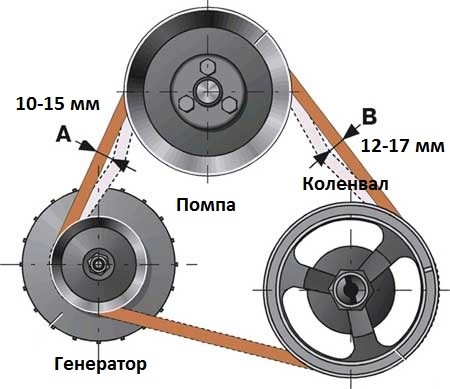

Video: varieties of water pumps of classic VAZ models


Watch this video on YouTube
Cooling system radiator
At its core, a radiator is a conventional heat exchanger. Due to the peculiarities of its design, it reduces the temperature of the antifreeze passing through it. The radiator is installed in the front of the engine compartment and is attached to the front of the body with four bolts.
The device and principle of operation of the radiator
The radiator consists of two plastic or metal horizontal tanks and pipes connecting them. The upper tank is equipped with a neck connected by a hose to the expansion tank, and a fitting for an underwater pipe through which heated coolant enters the radiator. The lower tank has a drain pipe through which the cooled antifreeze flows back into the engine.


On the tubes of the radiator, made of brass, there are thin metal plates (lamellas) that accelerate the heat transfer process by increasing the area of the cooled surface. The air circulating between the fins lowers the coolant temperature in the radiator.
The main malfunctions of the radiator of the cooling system
There are two reasons for the failure of the radiator:
- depressurization;
- decrease in the throughput of the tubes as a result of clogging.
The main sign of depressurization of the radiator is the leakage of antifreeze from it. You can restore its performance by soldering, but this is not always advisable. Often after soldering, the radiator starts to flow in a different place. It is much easier and cheaper to replace it with a new one.
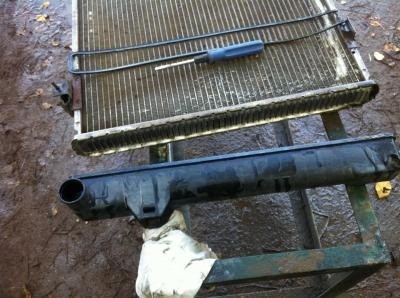

Clogged tubes are eliminated by flushing the radiator with special chemicals widely available in car dealerships.


In this case, the radiator is removed from the car, filled with flushing fluid and left for a while. Then it is washed with running water.
Video: replacing the radiator of the VAZ 2101 cooling system


Watch this video on YouTube
Cooling Radiator Fan
With increased loads on the engine, especially in the summer, the radiator may not be able to cope with its tasks. This can cause the power unit to overheat. For such situations, forced cooling of the radiator with a fan is provided.
The device and principle of operation of the fan
On later VAZ models, the cooling system fan turns on by a signal from a temperature sensor when the coolant temperature rises critically. In the VAZ 2101, it has a mechanical drive and works constantly. Structurally, it is a plastic four-blade impeller pressed onto the hub of the water pump pulley, and is driven by the generator and pump drive belt.


Main fan malfunctions
Given the simplicity of the design and fan drive, it has few breakdowns. These include:
- broken belt;
- belt loosening;
- mechanical damage to the impeller.
All these malfunctions are diagnosed in the process of inspecting the fan and checking the belt tension. Belt tension is adjusted or replaced as needed. The latter is also necessary in case of mechanical damage to the impeller.
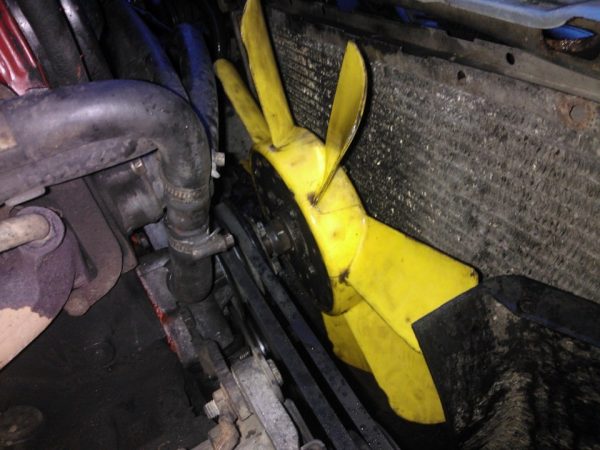

heating system radiator
The heating radiator is the main unit of the stove and is used to heat the air entering the passenger compartment of the car. The function of the coolant here is also performed by the heated coolant. The radiator is installed in the central part of the stove. The temperature and direction of the flow of air entering the passenger compartment is regulated by dampers and a tap.


The device and principle of operation of the stove radiator
The heating radiator is arranged in the same way as the cooling radiator. It consists of two tanks and tubes with lamellas. The differences are that the dimensions of the stove radiator are noticeably smaller, and the tanks do not have necks. The radiator inlet pipe is equipped with a tap that allows you to block the flow of hot refrigerant and turn off the interior heating in the warm season.
When the valve is in the open position, hot coolant flows through the radiator tubes and heats up the air. The latter enters the salon either naturally or is blown by a stove fan.
The main malfunctions of the stove radiator
The stove radiator can fail for the following reasons:
- clogging of the tubes of the device (complete or partial obstruction);
- depressurization of the radiator caused by corrosion;
- faucet malfunction (souring or leaking).

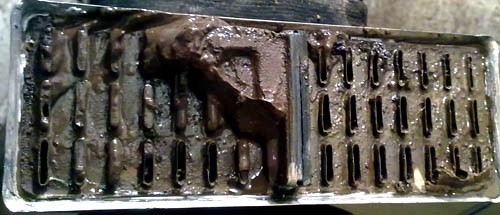 One of the main reasons for the failure of the stove radiator is clogging
One of the main reasons for the failure of the stove radiator is clogging
It is not difficult to diagnose a malfunction of the stove radiator. To check for clogging of the tubes, it is enough to touch the inlet and outlet pipes with your hand when the engine is warm. If they are both hot, the coolant circulates normally inside the device. If the inlet is hot and the outlet is warm or cold, the radiator is clogged. There are two ways to solve this problem:
- replacing the stove radiator with a new one;
- flushing the radiator using chemically active substances.
Video: flushing the radiator of the VAZ 2101 stove
Radiator depressurization manifests itself in the form of traces of coolant on the carpet under the dashboard or fumes that condense in the form of a white oily coating on the inside of the windshield. Similar symptoms are inherent in faucet leaks. For complete troubleshooting, the failed part is replaced with a new one.
Video: replacing a heater radiator on a VAZ 2101


Watch this video on YouTube
Often there are breakdowns of the crane associated with its acidification. This usually happens when the faucet has not been used for a long time. As a result, the parts of the locking mechanism stick to each other and stop moving. In this case, the valve should also be replaced with a new one.
Thermostat
The thermostat is a device designed to adjust the coolant temperature in different operating modes of the power unit. It accelerates the warm-up of a cold engine and ensures the optimum temperature during its further operation, forcing the coolant to move in a small or large circle.
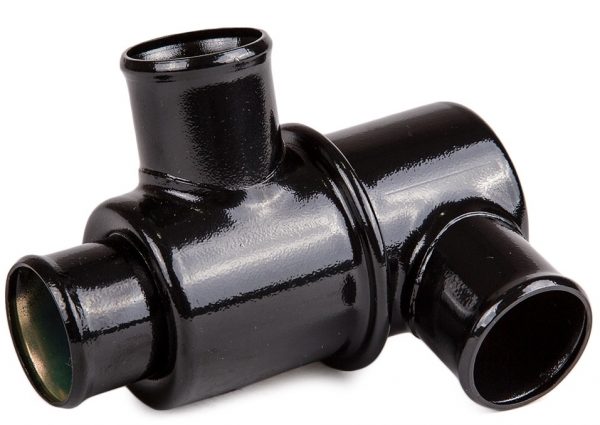

The thermostat is located on the right front of the power unit. It is connected by pipes to the engine cooling jacket, water pump and the lower tank of the main radiator.
Device and principle of operation of the thermostat
The thermostat consists of:
- housing;
- temperature sensitive element;
- main and bypass valves.
The main unit of this design is a thermoelement consisting of a metal cylinder containing technical paraffin, which can increase in volume when heated, and a rod.
On a cold engine, the main thermostat valve is closed, and the coolant circulates from the jacket through the bypass valve to the pump, bypassing the main radiator. When the refrigerant is heated to 80–85оWith the thermocouple is activated, partially opening the main valve, and the coolant begins to flow into the heat exchanger. When the refrigerant temperature reaches 95оC, the thermocouple stem extends as far as it will go, fully opening the main valve and closing the bypass valve. In this case, antifreeze is directed from the engine to the main radiator, and then returns to the cooling jacket through the water pump.
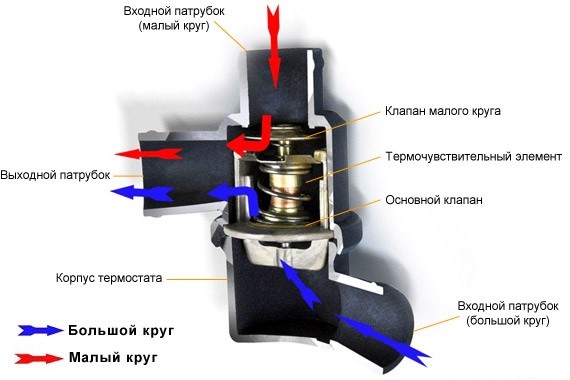

The main malfunctions of the thermostat
With a faulty thermostat, the engine may either overheat or not reach operating temperature at the right time. To check the performance of the device, you need to determine the direction of movement of the coolant on a cold and warm engine. To do this, you need to start the engine, wait two or three minutes and touch the pipe that goes from the thermostat to the upper radiator tank with your hand. It must be cold. If it is warm, the main valve is constantly open. As a result, the engine warms up longer than the set time.
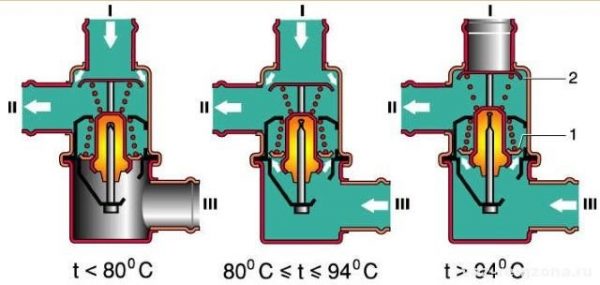

Another thermostat malfunction is the main valve jamming in the closed position. In this case, the coolant constantly moves in a small circle, bypassing the main radiator, and the engine may overheat. You can diagnose this situation by the temperature of the upper pipe. When the gauge on the instrument panel shows that the coolant temperature has reached 95оC, the hose must be hot. If it is cold, the thermostat is defective. It is impossible to repair the thermostat, therefore, if a malfunction is detected, it is replaced with a new one.
Video: replacing the thermostat VAZ 2101


Watch this video on YouTube
Expansion tank
Antifreeze, like any other liquid, expands when heated. Since the cooling system is sealed, its design must have a separate container where the refrigerant and its vapors could enter when heated. This function is performed by an expansion tank located in the engine compartment. It has a translucent plastic body and a hose connecting it to the radiator.
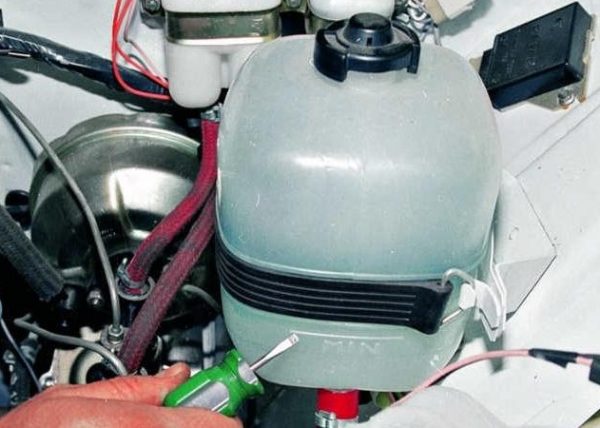

The device and principle of operation of the expansion tank
The tank is made of plastic and has a lid with a valve that maintains pressure at 1,3–1,5 atm. If it exceeds these values, the valve opens slightly and releases refrigerant vapor from the system. At the bottom of the tank there is a fitting to which a hose is attached that connects the tank and the main radiator. It is through it that coolant vapor enters the device.
The main malfunctions of the expansion tank
More often than not, the tank lid valve fails. At the same time, the pressure in the system begins to rise or fall sharply. In the first case, this threatens to depressurize the system with a possible rupture of the pipes and coolant leakage, in the second, the risk of antifreeze boiling increases.
You can check the serviceability of the valve using a car compressor or a pump with a pressure gauge. This is done in the following way.
- The coolant drains from the reservoir.
- A compressor or pump hose is connected to the tank fitting using a larger diameter hose and clamps.
- Air is forced into the tank and the readings of the manometer are controlled. The lid must be closed.
- If the valve operates before 1,3 atm or after 1,5 atm, the tank cap must be replaced.
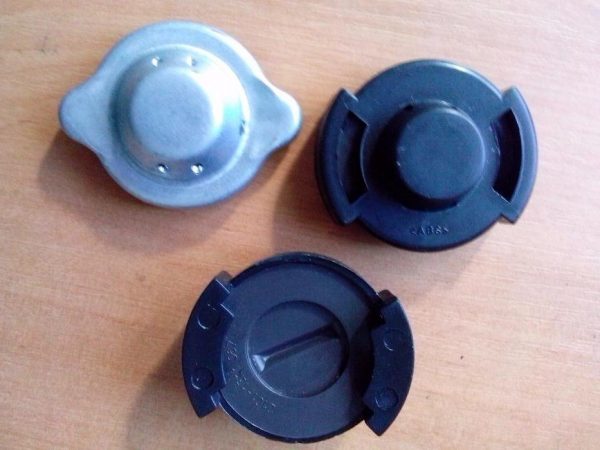

The malfunctions of the tank should also include mechanical damage, which can be caused by excess pressure in the system. As a result, the body of the tank may be deformed or torn. In addition, there are frequent cases of damage to the threads of the neck of the tank, due to which the lid cannot ensure the tightness of the system. In all these cases, the tank needs to be replaced.
Coolant temperature sensor and gauge
The temperature sensor is used to determine the temperature of the coolant inside the engine and transmit this information to the dashboard. The sensor itself is located on the front of the cylinder head next to the candle of the fourth cylinder.


To protect against dirt and technical liquids, it is closed with a rubber cap. The coolant temperature gauge is located on the right side of the instrument panel. Its scale is divided into two sectors: white and red.
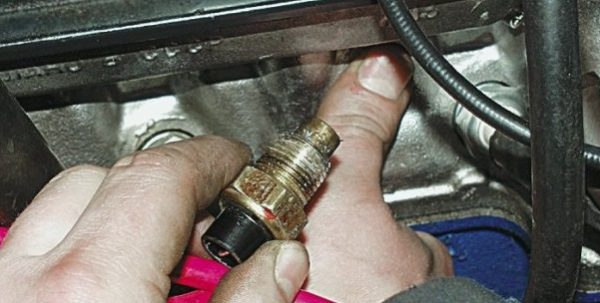

Design and principle of operation of the coolant temperature sensor
The operation of the temperature sensor is based on the change in the resistance of the working element during heating or cooling. A voltage equal to 12 V is applied to one of its terminals through the wire. From the other terminal of the sensor, the conductor goes to the pointer, which reacts to a decrease (increase) in voltage by deviating the arrow in one direction or another. If the arrow is in the white sector, the engine is operating at normal temperature. If it goes into the red zone, the power unit overheats.
The main malfunctions of the sensor and the coolant temperature gauge
The temperature sensor itself fails extremely rarely. More often problems are connected with wiring and contacts. When diagnosing, you should first check the wiring with a tester. If it is working, go to the sensor. It is checked as follows:
- The sensor is unscrewed from the seat.
- The probes of a multimeter switched on in ohmmeter mode are connected to its conclusions.
- The whole structure is lowered into a container with water.
- The container is heating up.
- The resistance of the sensor is fixed at different temperatures.
The resistance of a good sensor, depending on the temperature, should change as follows:
- 20оC - 3,0–3,5 kOhm;
- 40оC - 2,0–2,5 kOhm;
- 60оC - 0,65–0,5 kOhm;
- 90оC - 0,3–0,25 kOhm.
If the measurement results do not match the specified data, the sensor must be replaced.
Video: replacing the coolant temperature sensor VAZ 2101


Watch this video on YouTube
As for the temperature gauge, it is almost eternal. There are, of course, troubles with him, but very rarely. Diagnosing it at home is quite problematic. It is much easier, after making sure that the sensor and its wiring are in good condition, to buy a new device.
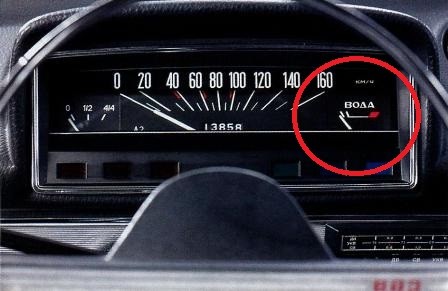

Branch pipes and hoses of the cooling system
All elements of the cooling system are connected by pipes and hoses. All of them are made of reinforced rubber, but have different diameters and configurations.
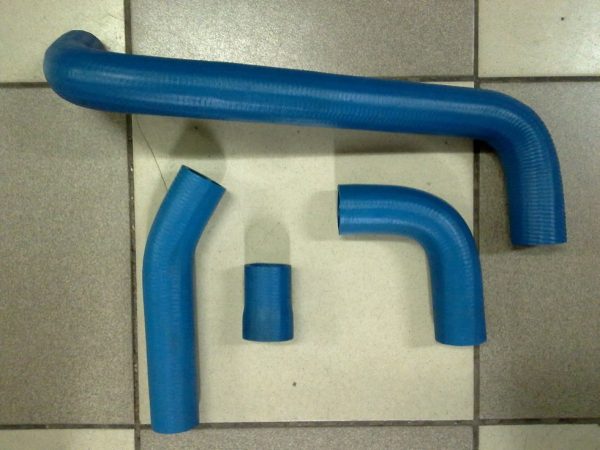

Each branch pipe and hose of the VAZ 2101 cooling system has its own purpose and name.
Table: pipes and hoses of the cooling system VAZ 2101
| Name | Connecting nodes |
| Branch pipes | |
| Underwater (long) | Cylinder head and upper radiator tank |
| Underwater (short) | Water pump and thermostat |
| bypass | Cylinder head and thermostat |
| Bypass | Lower radiator tank and thermostat |
| Hoses | |
| Underwater heater | Cylinder head and heater |
| Drain heater | Heater and fluid pump |
| Connective | Radiator neck and expansion tank |
Malfunctions of branch pipes (hoses) and their elimination
Pipes and hoses are subject to constant temperature loads. Because of this, over time, the rubber loses its elasticity, becomes rough and hard, which can lead to coolant leakage at the joints. In addition, the pipes fail when the pressure in the system increases. They swell, deform and even break. Pipes and hoses are not subject to repair, therefore they are immediately replaced with new ones.


Replacing pipes and hoses is quite simple. All of them are attached to the fittings using spiral or worm clamps. To replace, you need to drain the coolant from the system, loosen the clamp, remove the defective pipe or hose, install a new one in its place and secure with a clamp.
Video: replacing the pipes of the VAZ 2101 cooling system


Watch this video on YouTube
Coolant
As a refrigerant for the VAZ 2101, the manufacturer recommends using A-40 antifreeze. But recently, most owners of classic VAZ models use antifreeze, arguing that it is much more efficient and safer. In fact, for the engine there is not much difference what kind of coolant is used. The main thing is that it copes with its tasks and does not harm the cooling system. The only real danger is low-quality products containing additives that contribute to corrosion of the internal surfaces of the cooling system components, in particular, the radiator, pump and cooling jacket. Therefore, when choosing a refrigerant, you need to pay attention not to its type, but to the quality and reputation of the manufacturer.
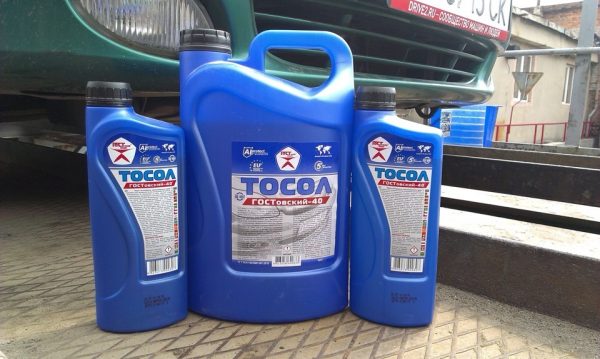

Flushing the cooling system VAZ 2101
Whatever fluid is used, dirt, water and corrosion products will always be present in the cooling system. To reduce the risk of clogging of the channels of the jacket and radiators, it is recommended to flush the system periodically. This should be done at least every two to three years. Flushing the cooling system is carried out in the following order:
- Coolant is completely drained from the system.
- The cooling system is filled with a special flushing fluid.
- The engine starts and runs for 15–20 minutes at idle.
- The engine is off. The flushing liquid is drained.
- The cooling system is filled with new refrigerant.
As a flushing liquid, you can use special formulations that are widely available on the market, or distilled water. It is strongly not recommended to use Coca-Cola, citric acid and household chemicals, as they can cause serious damage to the engine.
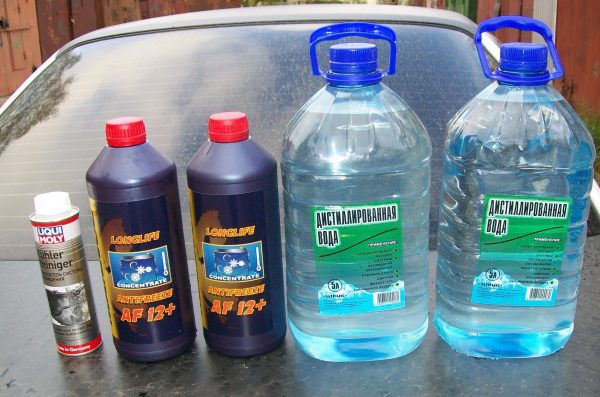

The possibility of finalizing the cooling system VAZ 2101
Some VAZ 2101 owners are trying to improve the efficiency of their car's cooling system. Popular improvements include:
- installation of an electric fan on the main radiator;
- the use of silicone pipes;
- replacing the standard thermostat with a thermostat from other VAZ models;
- installation of an additional water pump in the heater inlet hose.
However, the feasibility of such tuning is quite debatable. The cooling system of the VAZ 2101 is already quite effective. If all its nodes are working, it will perfectly perform its functions without additional modifications.
Thus, the performance of the VAZ 2101 cooling system largely depends on the attention of the car owner. If the refrigerant is replaced in a timely manner, to prevent the engine from overheating and a sharp increase in pressure, it will not fail.


